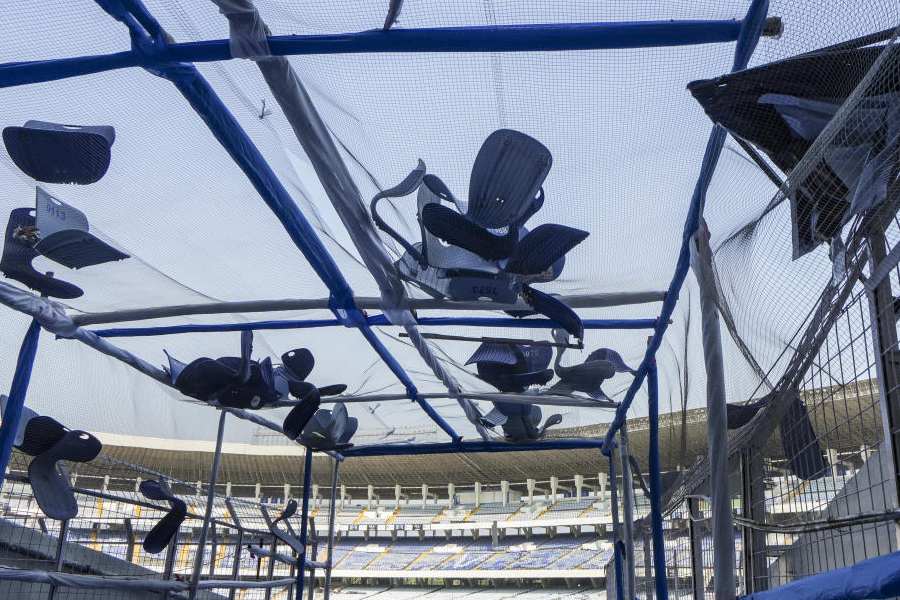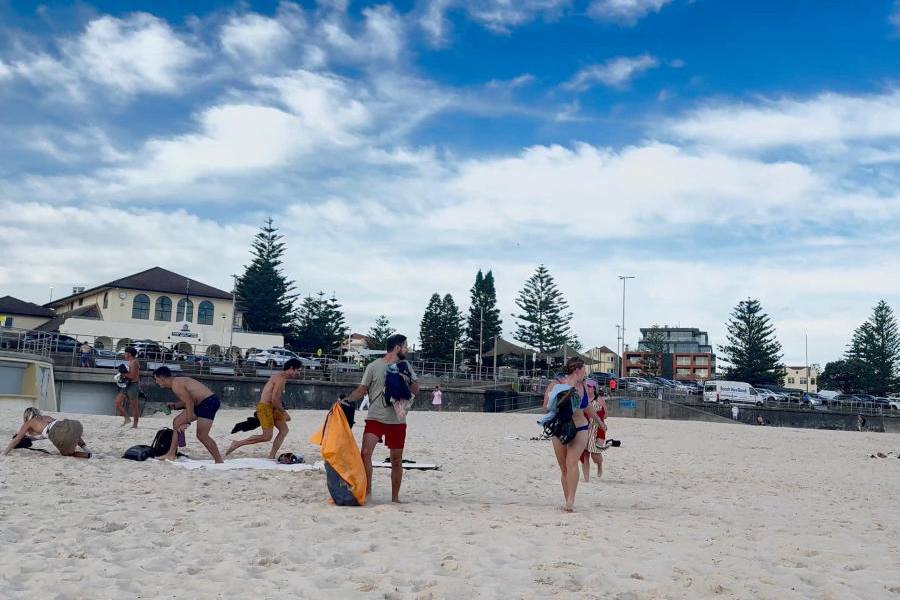 |
 |
 |
 |
| Rabia Gupta has designed BEST bus-inspired totes and a range of other products inspired by Mumbai’s taxi graphics GAJANAN DUDHALKAR |
Divya Thakur is not your ordinary run-of-the-mill graphic designer who’s doing just branding work for companies. She calls herself as a “communicator of sorts” and says that her inspiration comes from things happening around her. She has criss-crossed between Indian cultures and experimented with Indian mythology in her range of lifestyle products that appeal to an urban audience because of their fun elements.
Cut to Delhi where graphic designer Himanshu Dogra has opened Play Clan — his “ fashion+art+design store” with a motley group of creative professionals like copywriters, illustrators and writers at the Select City Walk in Saket. Dogra’s work is a mix of pop art and kitsch with playful concepts based on the humour in Indian clichés. His collection includes stationery, hand-painted shoes, journals and bags depicting the ‘sab chalta hai attitude of Indians’ with everything from urban street graphics to street-lingo to Indian automobiles finding its way on these products.
Thakur and Dogra belong to a larger movement that’s taking place in India where designers are coming up with everyday products by drawing on the rich craft traditions of India. Call it Indi-pop or kitsch — desi homegrown products borrowing heavily from Indian mythology and history with humour attached to it seem to be the newest buzzword in product designing.
Says Krunal Rawat, creative director, Grandmother India: “What passes as ordinary in everyday life has become the topic of interest for these designers. Designers today see the Indian urban space as an untapped format for personal artwork.” Rawat, who’s working on a line of products which will be out soon, says that “the products should be quirky bearing the stamp of urban India and at the same time be rooted in Indian ethos”.
Indeed, for many graphic designers it makes sense to draw inspiration from India. Says Pradyumna Vyas, director, National Institute of Design (NID), Ahmedabad: “The biggest change today is that designers are getting confident in Indian visual language and trying to highlight these in a contemporary fashion in their artworks. As the economy grows, Indian art and culture is accepted abroad and as a result the local identity is getting recognised. Graphic designers play an important role in giving expression to this identity.” According to Vyas, an interest in Indian typography (Indian script) is finding expression in packaging and magazine design.
 |
 |
 |
| You can’t miss the humour in Divya Thakur’s work, whether it’s her Mahabharata-inspired toilet paper or her First-Vaid medicine box with the face of a tilak-clad village healer on it GAJANAN DUDHALKAR |
Vyas says that the trend of using India-specific visual language started first with fashion designers and artists a decade back and is now influencing product designers.
Meanwhile, there is Rabia Gupta who argues that, “As Indians, we always tried to ape Western sensibilities because that was considered cool. Not any longer as we have started to look seriously at the rich heritage of Indian design.” Gupta, who set up her graphic design company called Rabia Gupta Designs in Mumbai way back in 1997, took to designing lifestyle products (available at Good Earth, Mumbai) “more out of passion” three years ago.
Born and brought up in Calcutta, Gupta studied visual arts at Wesleyan College in the US and then did a visual communication course at NID, Ahmedabad. She worked as art director at Ambience Advertising and Trikaya Grey before setting up her own studio Rabia Gupta Designs.
Gupta has been inspired by Mumbai’s taxi graphics and printed them on an array of home-décor items like cocktail plates, cushion covers, coffee mugs and acrylic coasters. Says Gupta: “These cabs are not just black and yellow, but have unbelievable graphics and texture painted on them.”
 |
 |
 |
| Himanshu Dogra’s collection includes lamp shades and journal covers depicting everything from urban street graphics to Indian automobiles |
In her second line, called ‘India Everyday’, she has been inspired by the packaging design of everyday grocery items and the outcome is a variety of silk coasters depicting market scenes, Mumbai’s BEST bus-inspired totes and sling bags and Mumbai’s chaiwallah inspired trays. Prices range between Rs 800 to Rs 3,000.
In Thakur’s work, you can’t miss the humour — for instance she has used toilet paper to depict the disrobing scene of Draupadi by Duryodhana. Equally interesting is her travel bag designed like the Indian zero (shunya) or the ‘First-Vaid box’ (to store medicines) with the face of a tilak-clad village vaid (doctor). Says Thakur: “Part of my agenda is to bring in certain respectability to everything Indian.”
Thakur’s products are available at The Conran Shop (London, Tokyo, Paris), Good Earth (Mumbai and Delhi), Grasshopper and Cinnamon (Bangalore) and Amethyst and Chamiers (Chennai).
So what makes graphic designers present Indian-inspired lines of products? Says Rawat: “A graphic designer’s job is to visually represent an idea or a message and being Indians we have the advantage of having such images rooted in our culture.”
So how are these individual designers holding their own in a market where brand names are everything? Dogra recalls that it was initially tough to convince the mall’s owners to allow them to open a small store. His products (priced between Rs 250-Rs 5,000) are based on tongue-in-cheek themes – like the ‘Indian Standard Tamasha’ depicting babus to politicians to autorickshaws to iconic city landmarks of Delhi and the ‘Loveless’ theme (which are anti-love merchandise consisting of tees, notepads and badges showing the loveless monster icon).
 |
 |
 |
| Aarohi Singh quit her job as a web designer to become a full-time product designer www.artbyaarohi.com |
Using Indian local themes in a globalised world is something which London based husband-wife designer duo Jonathan Levien and Nipa Doshi does in their line of branded furniture like the high-end charpoy range which borrows from Indian designs. They have taken their inspiration from Mughal miniature paintings in a seating collection called ‘My Beautiful Backside’ which was launched in Milan in Salone 08.
Meanwhile there’s Delhi-based Gunjan Gupta whose work involves synthesising traditional craft and contemporary design into bespoke furniture from her design studio Wrap. She says: “I work with Indian artisans and my designs are all inspired by traditional Indian furniture. But I turn it around to make it more trendy to suit today’s interiors.” Some gems in her furniture line include ‘Dumroo’ based on the handheld musical instrument used by monkey dancers in India, ‘Eastern Recline’ based on the reclining chairs in India and made of pure silver, teakwood and gold leaf and ‘Bicycle Throne’ using old bicycle parts. Prices range from Rs 1 lakh to Rs 5 lakh. Her products sell at Good Earth, Delhi and Bungalow 8, Mumbai.
Luckily for these designers the top design stores also need their products as home accessories are becoming must-haves for every home. There’s also Delhi-based graphic designer Nikki Duggal whose mainstay is “keeping the humour intact.” Her design studio Mixed Juice Design in Delhi’s Greater Kailash churns out hip stationery and home-décor items with an element of fun attached to it. She retails her stuff from Loose Ends, Mumbai and Dcube, Hyderabad.
 |
 |
| Nikki Duggal designs products like these quirky matchboxes depicting city life with an element of fun attached to them GAJANAN DUDHALKAR |
Duggal equates India with a glass of mixed juice “ as it takes all kinds of colours, flavours, tastes and appearances to make us who we are.” On offer are provocative playing cards with Bollywood celebrities, funky visiting cards depicting urban life, limited-edition prints, coasters and matchboxes. Prices start as low as Rs 50 and go upwards till Rs 7,000.
At another level, these designers have created an awareness that never existed before. “People today are well-travelled and are aware of design trends. As a result design is getting smarter with Indians ready to splurge on niche products,” says Vyas.
Take for instance, Bangalore based designer Aarohi Singh who chucked up her job as an information-architect (web-designer) in indya.com (2000) and is today a full-time product designer developing kitschy home décor items for her clients. “It all started by painting an aluminium kettle in bright colours,” she says.
 |
 |
 |
| Lokesh Karekar draws inspiration from Indian folk art, especially in his limited edition art prints. Another notable line-drawing of his is the Valentine’s Day ice-cream with heart-shaped cones (top) |
Her Indian sensibility is seen in her products (prices vary between Rs 2,000 and Rs 40,000) which are drenched in loud colours and have funny names like the Singh Is King kettle (infused with Sikh symbolism) the Nazar battoo series on kettles (inspired by the black dot put on kids’ cheeks to ward off the evil eye) and the ‘item bomb tables’ (painted Bollywood item dancers and Bharatnatyam dancers) or the trunk which has a face of a Kathakali dancer on it. She retails mainly from her home studio and also from design stores like Levitate in Bangalore.
Another newcomer to the scene in Mumbai is Lokesh Karekar who feels that graphic designers should not restrict themselves to only print or web design but should look at newer avenues of design. An alumnus from the J.J. School of Art, Mumbai who specialised in typography design, Karekar has worked as an art director in design firms like Flagship, Grandmother India and Alok Nanda Company. Today, he works independently from his own graphic design studio Locopopo in Mumbai’s Mahim area and draws his visual identity from Indian folk tradition and urban city life.
His product range includes limited editions of line drawings (one of the notable ones include Valentine’s Day ice-cream with dil- or heart-shaped cones and screen prints of ambassador cars), coasters and T-shirts which he sells online and which are priced between Rs 2,500 and Rs 4,000. He says: “I am always inspired by a good visual which can be a vintage poster or a bustling marketplace.”
So what’s the future for these products? Gupta is optimistic and says, “The future looks bright with Indian contemporary design poised to grow. But it’s up to us to take it to greater limits without compromising on quality.”










